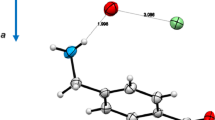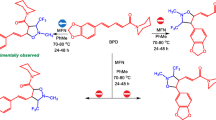Conclusions
The changes in the chemical shifts of organic molecules during complex formation are well known in organometallic chemistry [24]. Thus, coordinated dienes lose the olefinic characteristics; they are not hydrogenated, do not enter into the Diels-Alder reaction, and react with electrophilic reagents. At the present time the search for a link between the structure of organometallic complexes in terms of rigorous quantum-chemical calculations is beginning. The construction of experimentally substantiated models which make it possible to explain qualitatively the marked changes in the characteristics of organic compounds in the presence of the atoms of transition metals is therefore essential for a deeper understanding of the orbital mechanisms lying at the basis of catalysis.
The PE spectra were measured on an ÉS 3201 electron spectrometer with an inlet system heated to 200°C. The resolution, determined from the width of the2P3/2Xe band at the half-height, amounted to 40 meV. Compounds (II) and (III) were obtained by the previously described methods [25, 26], and the analytically pure substances were used for the investigation.
Similar content being viewed by others
Literature cited
M. Elian and R. Hoffmann, Inorg. Chem.,14, No. 5, 1058 (1975).
M. Elian, M. M. L. Chen, D. P. M. Mingos, and R. Hoffmann, Inorg. Chem.,15, 1148 (1976).
R. Hoffmann, Science,211, No. 4486, 995 (1981).
B. E. Bursten and R. F. Fenske, Inorg. Chem.,18, 1760 (1979).
E. L. Andersen, T. P. Fehlner, A. E. Foti, and D. R. Shalahub, J. Am. Chem. Soc.,102, 7427 (1980).
H. Bock and B. G. Romsey, Angew. Chem. Int. Ed. Engl.,12, 734 (1973).
M. C. Böhm, J. Chem. Phys.,78, 7044 (1983).
M. J. S. Dewar and S. D. Worley, J. Chem. Phys.,50, 654 (1969).
J. A. Connor, L. M. R. Derrick, I. H. Hillier, et al., Mol. Phys.,28, 1193 (1974).
S. D. Worley, T. R. Webb, T. N. Gibson, and T. S. Ong, J. Electron. Spectros. Relat. Phenom.,18, 189 (1980).
J. C. Green, P. Powell, and J. Tilberg, J. Chem. Soc., Dalton Trans., 1974 (1976).
K. Tatsumi and T. Fueno, Bull. Chem. Soc. Jpn.,49, 929 (1976).
P. G. Perkins, I. C. Robertson, and J. M. Scott, Theor. Chim. Acta,22, 229 (1971).
M. C. Böhm, J. Mol. Struct.,92, 73 (1983).
D. Guenzburger et al., J. Chem. Phys.,80, 735 (1984).
D. W. Turner, C. Baker, A. D. Baker, and C. R. Brundle, Molecular Photoelectron Spectroscopy, Wiley, New York (1970).
G. Herzberg, Electronic Spectra and Structure of Polyatomic Molecules, Van Nostrand (1966).
M. I. Davis and C. S. Speed, J. Organomet. Chem.,21, 401 (1970).
G. M. Mohay and G. A. Osborne, Spectrochim. ActaA23, 909 (1967).
Yu. A. Borisov and I. I. Kritskaya, Izv. Akad. Nauk SSSR, Ser. Khim.,3, 576 (1984).
V. G. Andrianov, Yu. T. Struchkov, G. M. Babakhina, et al., Izv. Akad. Nauk SSSR, Ser. Khim., in press.
R. E. Davis and R. Pettit, J. Am. Chem. Soc.,92, 716 (1970).
E. P. Smirnov, in: Advances in Photonics [in Russian], Izd. LGU, Leningrad (1980), Vol. 7, p. 167.
S. P. Gubin, in: Methods of Heteroorganic Chemistry. Complexes of Transition Metals with Dienes, Arenes, and Compounds with an M-C σ-Bond [in Russian] (editors A. N. Nesmeyanov and K. A. Kocheshkov), Nauka, Moscow (1976), pp. 7–126.
R. Victor, R. Ben-Shoshan, and Sh. Sarel, J. Org. Chem.,37, 1930 (1972).
T. A. Manuel, Inorg. Chem.,3, 1749 (1964).
Additional information
Scientific-Research Institute of Physics, A. A. Zhdanov Leningrad State University. A. N. Nesmeyanov Institute of Heteroorganic Compounds, Academy of Sciences of the USSR. Translated from Zhurnal Strukturnoi Khimii, Vol. 27, No. 3, pp. 69–75, May–June, 1986.
Rights and permissions
About this article
Cite this article
Chizhov, Y.V., Timoshenko, M.M., Kleimenov, V.I. et al. Investigation of the mechanism of fragment coordination of aromatic molecules with transition metals by photoelectron spectroscopy-tricarbonyliron complexes. J Struct Chem 27, 401–406 (1986). https://doi.org/10.1007/BF00751819
Received:
Issue Date:
DOI: https://doi.org/10.1007/BF00751819




